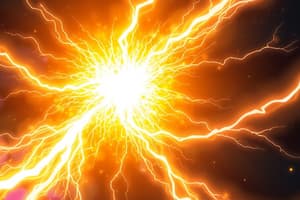Podcast
Questions and Answers
What is the process of charging an object by conduction?
What is the process of charging an object by conduction?
- Rubbing two objects together to transfer electrons.
- Inducing a charge in a neutral object by bringing a charged object close.
- Transferring electrons through direct contact with a charged object. (correct)
- Causing a rearrangement of charges without contact.
When two different materials are rubbed together, what charge does each material acquire?
When two different materials are rubbed together, what charge does each material acquire?
- One becomes negatively charged and the other positively charged. (correct)
- Neither becomes charged.
- Both become negatively charged.
- Both become positively charged.
What is the key difference between an ammeter and a voltmeter?
What is the key difference between an ammeter and a voltmeter?
- An ammeter measures voltage while a voltmeter measures current.
- An ammeter measures electrical current, and a voltmeter measures voltage. (correct)
- An ammeter measures potential difference and a voltmeter measures resistance.
- An ammeter is used in parallel and a voltmeter in series.
Which statement is true regarding insulators and conductors?
Which statement is true regarding insulators and conductors?
What happens to the charges within a neutral object when a charged object is brought close to it?
What happens to the charges within a neutral object when a charged object is brought close to it?
Flashcards
Law of Electrostatics
Law of Electrostatics
Like charges repel each other, while opposite charges attract.
Charging by Conduction
Charging by Conduction
Transfer of charge by direct contact between a charged object and a neutral object. Electrons move from the charged object to the neutral object giving them both the same charge.
Charging by Friction
Charging by Friction
Transfer of charge by rubbing two objects together. Electrons are transferred from one object to the other, making one object negative and the other positive.
Charging by Induction
Charging by Induction
Signup and view all the flashcards
Conductors
Conductors
Signup and view all the flashcards
Study Notes
Electrostatics
- Like charges repel, opposite charges attract.
Charging Methods
- Conduction: Electrons transfer from a charged object to a neutral object, resulting in both objects having the same charge. (Example: Rod to sphere)
- Induction: A charged object brought near a neutral object causes a rearrangement of charges within the neutral object, without direct contact. Electrons move within the object. (Example: Balloon to wall)
- Friction: Rubbing two different materials together transfers electrons from one to the other. This results in one object becoming negatively charged and the other positively charged. (Example: Balloon to sweater)
Definitions
- Charging by Conduction: Transferring charge by direct contact between a charged object and a neutral object.
- Charging by Friction: Transferring charge by rubbing two different materials together.
- Charging by Induction: Transferring charge without direct contact through the influence of a charged object on a neutral object.
Electrical Measurements
-
An ammeter measures current (flow of charge) in a circuit.
-
A voltmeter measures voltage (potential difference) across a component or circuit.
-
Ammeters are connected in series with the circuit.
-
Voltmeters are connected in parallel across the component or circuit.
Conductors and Insulators
- Conductors: Materials that allow electric current to flow easily due to free-moving electrons. (e.g., Copper)
- Insulators: Materials that limit or block the flow of electric current, with electrons tightly bound. (e.g., Rubber)
Studying That Suits You
Use AI to generate personalized quizzes and flashcards to suit your learning preferences.




